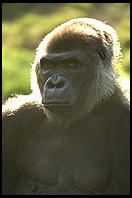
Portrait Photography
by Philip Greenspun; revised January 2007
Site Home : Photography : Portraits
A face devoid of love or grace,
A hateful, hard, successful face,
A face with which a stone
Would feel as thoroughly at ease
As were they old acquaintances,--
First time together thrown.
-- "A Portrait" by Emily Dickinson
Below are two photos by world-famous portrait photographer. Elsa has the same kind of studio, background, lights, and equipment as a lot of folks with more technical skill. Yet those folks aren't portrait photographers and Elsa is. What's the difference? Elsa cares about people. She is genuinely curious about people she has never met and can connect with them in just a few minutes. After a one-hour session, she knows more about her average subject's life than I do about my sister's.
Elsa uses a 20x24" Polaroid camera. Film costs about $50/exposure, so she limits herself to two exposures per subject. Yet her photo of me and Alex (below right) is one of the only pictures of myself that I like. Our advice to digital photographers is to fill the flash card with at least 50 images in hopes of yielding one that captures the essence of a subject's expression.
Elsa's artistic success implies that the most important thing about portrait photography is an interest in your subject. If you are so busy working that you can't care about strangers, don't take their photos! Or at rate, don't expect those photos to be good. Some of my better portraits were taken on a trip to Alaska and back because I had 3.5 months in which to be alone and learn to appreciate the value of a stranger's company and conversation.
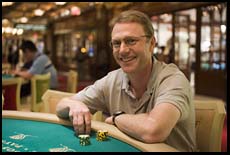
If you don't have or can't create a photo studio, concentrate on environmental portraiture. Show the subject and also his surroundings. These tend to work best if you can enlarge the final image to at least 11x14 inches. In any smaller photo, the subject's face is simply too small. Taking photos that will enlarge well is a whole art by itself. Your allies in this endeavor will be a low ISO setting, prime (rather than zoom) lenses, a tripod, and at least a mid-range digital SLR.
There are two elements to a photo studio for portrait photography. One is a controlled background. You want to focus attention on your subject and avoid distracting elements in the frame. Probably the best portraits aren't taken against a gray seamless paper roll. On the other hand, you are unlikely to screw up and leave something distracting in the frame if you confine yourself to using seamless paper or other monochromatic backgrounds. You don't have to build a special room to have a controlled background. There are all kinds of clever portable backdrops and backdrop supports that you can buy or build. If you absolutely cannot control the background, the standard way to cheat is to use a long fast lens, e.g., 300/2.8. Fast telephoto lenses have very little depth of field. Your subject's eyes and nose will be sharp. Everything else that might have been distracting will be blurred into blobs of color.
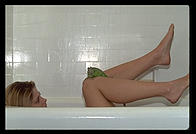
The second element of a portrait studio is controlled lighting. With lights on stands or hanging from the ceiling, you get to pick the angle at which light will strike your subject. With umbrellas and other diffusion equipment, you get to pick the harshness of the shadows on your subject (see out studio photography primer). There are some pretty reasonable portable flash kits consisting of a couple of lights, light stands, and umbrellas. These cost $500-1000 and take 20 minutes or so to set up on location. If you don't have the money, time, or muscles to bring a light package to a project, the standard way to cheat is to park your subject next to a large window and put a white reflecting card on the other side. Don't forget the tripod, because you'll probably be forced to use slow shutter speeds.
What if you don't have a big open space with diffuse light and a neutral background? Steal one. If you live in the United States, a vast open space with light pouring in from expensive skylights is as close as your nearest art museum or university. With a 200mm lens set to f/2.8, the background will be thrown out of focus. Here are some examples from the Boston Museum of Fine Arts and a couple of lobbies at MIT, taken on a cold February day in Boston. Canon EOS-5D, 70-200/2.8 IS lens, handheld without flash.
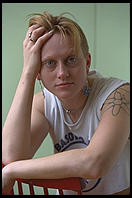
The most flattering light for most portraits is soft and off-camera. A large north-facing window works, as does the electronic equivalent, the softbox (light bank). The Elsa Dorfman Polaroid photo at the top right was taken with two large light banks, one on either side of the camera. Note that there are essentially no shadows.
If your subject is outdoors, an overcast day is best. If the day is sunny, make sure to use a reflector or electronic flash to fill in shadows underneath the eyes.
At right: In a New York loft, light coming from a bank of windows at left. Canon 70-200/2.8 lens on tripod. Possibly some fill-flash. Fuji ISO 400 color negative film.
More: the Light chapter of Making Photographs.
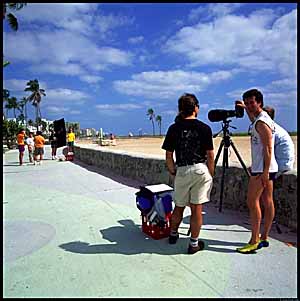
If you want to flatter your subject, you'll probably want to deemphasize his nose. That means you want to stand at 10 or 15 feet away from him so that his nose isn't significantly closer to you than the rest of his face. However, at such a large distance from the camera, filling the frame with just your subject's face will require a high magnification (i.e., telephoto) lens. Typical "portrait" lenses are therefore between 90 and 135 millimeters long (for 35mm cameras). Many professional fashion photographers use 300mm or 600mm lenses, resorting to using a walkie-talkie or bullhorn to communicate with the model!
At right: South Beach. Miami. Fashion photography capital of the world. Here a yuppie photographer sneers from the back of his 600/4. He's unhappy at being on the glass end of a Rollei 6008 and 50mm lens. The model is way down the beachfront and he's using a radio to communicate with an assistant holding a reflector by the model (in yellow).
With a Canon or Nikon, most professionals end up using their 70-200/2.8 or 80-200/2.8 zooms as portrait lenses. These 3 lb. monsters aren't very pleasant to handhold, though, and if you know that you're only going to do portraits, you're better off with a prime lens. Prime lenses are lighter and give better image quality. Unfortunately, the prime lens in this range that a serious photographer is most likely to own is the 100 or 105 macro. These are very high quality optically but difficult to focus precisely since most of the focusing helical precision is reserved for the macro range. Here are some great portrait lenses:
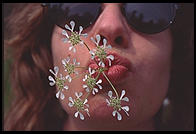
What if you're using a small-sensor digital SLR, such as any of the Nikons or the Canon Digital Rebel? In that case, an inexpensive 50/1.8 will function as a very usable portrait lens, roughly equivalent to the 85/1.8 short portrait lenses that are popular on full-frame cameras. Note that the background will not be as blurred as it would be with the longer lens.
There are folks who argue that a portrait should not be clinically sharp. For them, fuzz = glow and is flattering. Fuzz fans definitely don't like using standard 100mm macro lenses for portraiture. They'll start with a lower performance lens and add fuzziness with a filter (e.g., Zeiss Softar or Tiffen SoftFX), a stocking stretched over the lens, or digital post-processing.
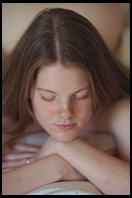
Connoisseurs of soft focus insist that you must have a lens with
uncorrected spherical aberration. You can get spherical aberration
either by using a very old camera/lens or by buying a purpose-built
modern soft focus lens. The image at right was taken with
a
As far as doing soft focus in other formats, Rodenstock makes an Imagon lens for 4x5 view cameras. This unusual lens has perforated disks that you slide into the middle of the lens. Unfortunately, different softness and aperture settings affect the focus, which requires focussing with the lens stopped down. In medium format, people like the old Zeiss 150 lens for Hasselblad because it simply isn't all that sharp.
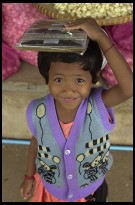
The standard place to start is a digital single-lens-reflex camera. If you can afford it, a full-frame digital camera, such as the Canon EOS 5D, is very nice for portraits because you get less depth of field for a given composition than with a small sensor camera, such as any of the Nikons or the Canon Digital Rebel.
For a serious challenge to digital SLR quality, start with a Hasselblad and a 150mm lens. If you have a flotilla of assistants like Annie Liebowitz, you could use the camera she uses: Mamiya RZ67. If you have a lot of patience, a 4x5 view camera with 270mm lens isn't a bad option.
How important is the choice of camera? Consider how terrible the pictures were that your relatives sent you back in the old days, taken with a zoom point and shoot film camera. The lenses was far too slow at the telephoto end. So the photo was taken at f/10 instead of f/2.8 and the background was sharp instead of blurry. Due to the slow aperture, Uncle Alfred had to use the on-camera flash instead of natural light. It was a waste of film.
How much better is life in the digital point and shoot age? Sadly, not much. The lenses are a little faster than on the old film P&S cameras, but the sensors are so small that the focal lengths are shorter and the depth of field is about the same, i.e., too great. The background is sharp when it should be blurry.
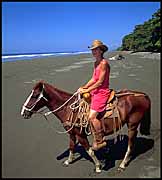
Here's a photo from Costa Rica. That's Diane Ewing, consummate horsewoman and proprietress of Hacienda Barú. Her face would be completely black if a pop from the built-in flash of the Canon EOS-5 (film) body had not filled in the shadow under her hat. Canon 20-35/2.8L zoom lens. Fuji Sensia film. Photographer also sitting on horse (tripod is generally preferable to quadruped).
Note that with environmental portaits, you don't necessarily use a "portrait-length" lens. In fact, often a wide angle lens of some kind is used, typically closer to 35mm than 20mm (full-frame/35mm film).
Here are some more examples of photos that might reasonably be called environmental portraits:
If the photo captures something that you remember about a person, there is no need to show the whole face clearly. The photo may have a lot of meaning to friends and family even if it doesn't communicate much to a stranger.
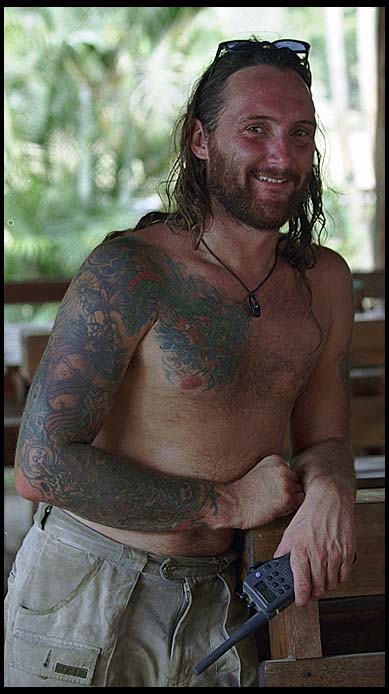
|
The photo at left (Dieter) was taken with a Canon 35-350L zoom lens. The 35-350L slows down to around f/5.6 at longer focal lengths. The photo at right (Emma) was taken in Alaska's Katmai National Park in front of a background with similar potential for distraction. Emma was captured on film with a 300/2.8 lens. You can decide for yourself whether the reduction in background distraction is worth the cost and weight of a fast lens. |
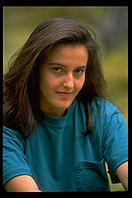
|
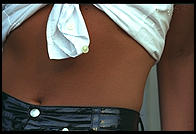
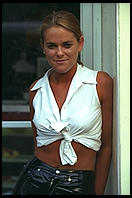
Though the big professional zooms are heavy and not as sharp as
primes, they encourage experimentation. At right is a standard
portrait from New York, captured down near
the 70mm end of the lens. With a quick twist, the
Miscellaneous Images with the 70-200, mostly in uncontrolled environments where the ability to blur the background by going to 200/2.8 was essential....
The rectangular format of most cameras encourages photographers to crop rather tightly around a subject's face or torso. The 6x6 cm square format encourages you to give subjects a little bit of space.
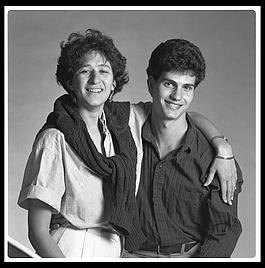 |
Roommates. Sadly marred by a technical flaw: the reflector edge in the lower left corner of the frame. |
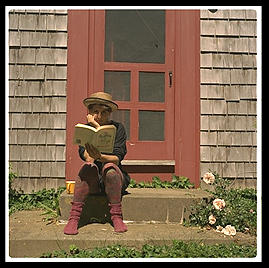 |
Reading. From Cape Cod. This was taken with the 80mm lens, a normal focal length for 6x6. If you're not trying to fill the frame with the subject's face, you don't need a telephoto lens to avoid an unflattering perspective. In medium format, this can result in big savings. A telephoto lens for a Hasselblad or Rollei 6000 is about $4000! |
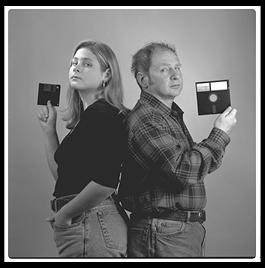 |
Generation Gap. |
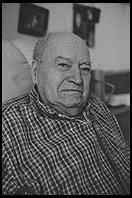
|
My grandfather Nick Gittes |
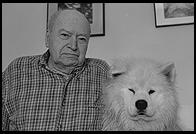
|
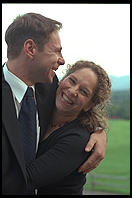 |
Cousin Douglas and wife Leslie at Harry and Katerina's wedding. Fuji NPH low-contrast wedding film, Canon EOS-3, 28-70/2.8L lens |
(but that might give you a good idea)
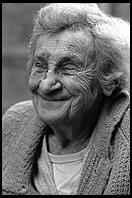
Most people probably look better in black and white. If you want the sharpest results, you'll get them with Agfapan 25, Kodak TMAX-100, and Kodak BW400CN. Kodak's ancient TRI-X emulsion has enough grain that it may flatter certain subjects. You will probably find that TRI-X in the 35mm format yields grain that is simply too obtrusive. TRI-X works very well in 120 or 4x5 size, however.
If you're doing color, you'll want subtle tones, low color saturation, and low-ish contrast. Good places to start in the color negative world are the Kodak Portra films, Fujicolor Pro 160S, and Fujicolor Pro 400H. For color slides, try Fuji Astia or Kodak E100.
See my film article for more on this subject.
At right: my grandmother Shirley on TRI-X.